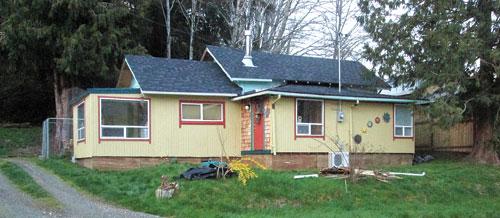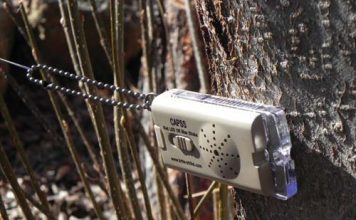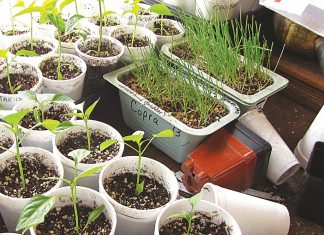| Issue #155 • September/October, 2015 |
December 2012. Welcome to my house as I first saw it.
The door opens onto a dirt-floored room. It’s not a garage, not a storeroom, not a laundry room, not a mud room. I’m not sure what it is. All I know is that it’s raining harder inside the room than it is outside. We squish our way across the floor. Maybe this is a mud room after all but only in the most literal sense.
Step up onto that bit of plywood decking over there, but be careful; it’s so rotted your foot might go straight through. Next we open a door to the kitchen and dining room. The dining room ceiling has collapsed. Drywall and insulation hang in damp clots. Dead insects crunch under our shoes. But all this is eclipsed by the reek of mold. The real estate agent who’s brought us here turns pale. Then she turns on her heel and walks out, muttering a quick apology about being unable to breathe.
You and I explore the rest of the place on our own. There’s a derelict bathroom some long-ago owner abandoned to mice and spiders. The “new” ¾ bathroom stuck next to it is only slightly better. That dark bedroom was hideous even before it was overtaken by rot. There’s a strange enclosed porch whose southwest corner sags by seven inches and whose water-logged carpet stinks of cat pee. That ought to be the main entry door over there, but the sagging structure has wedged it permanently shut. Besides, there’s a hole in the floor in front of it. Laundry hookups have, for no reason known to mankind, been plumbed into the living room wall. And everywhere there’s mold, mold, mold. There is not a surface in the house that isn’t black-spotted and reeking. Parts of the house are downright scary.
I go back outside and tell the real estate agent, “I don’t know whether this is a fixer upper or a tearer downer.” But I’m interested. Not at $35,000, though. No way. So we’ll just wait and see.

Above: The kitchen and dining room as they were when I bought the house.
Below: This is the dining room today. The floor still needs to be finished, but it’s quite an improvement.

Within the next two months the bank that owns the place drops the price precipitously. To $24,000. No takers. To $17,000. Still no takers. Then to $9,900. On that day, the vultures swoop in. The house gets three bids in a single afternoon. Mine is rejected. I’m not sure whether to feel regret or relief.
But little do I know, my story with This Olde Wreck is not over. The winning bidder never performs. (As I learn later) he somehow manages to keep the bank on the hook for nearly two months without ever even tendering his earnest money. The bank grants him contract extensions. He requires them to spend their funds on a septic tank inspection. They bend over backwards for him in every way until they can’t do it any more. On April 22, 2013, the house goes back on the market for $9,900. I bid again. So does the original winning bidder, who must have brass you-know-whats.
Once again, I’m facing a competitor who has outbid me. This time, though, the bank’s asset manager is done with him. The now-desperate bank accepts my $10,000 offer with a huge catch. They give me one week to produce the cash and close the sale. I gulp and sign the paperwork, having no idea how I’ll come up with that much money in a mere seven days.
“But I’ll do it,” I tell the real estate agent.
“I know you will,” she agrees. She’s worked with me before and knows I’m broke but resourceful.
I take an emergency loan from a client. I draw cash advances on credit cards. I empty my bank account. Eventually, I loot my penny jar and root under the couch cushions for spare change, the only way I can come up with an unexpected last-minute increase of $82.36 in the closing costs. On April 30, 2013, the house becomes mine.
But why on earth would a single, middle-aged woman with no notable building skills and so little money buy a wreck of a house like this? Ten thousand dollars may sound like a good deal for any piece of real estate. But with major work ahead from foundation to roof, anybody with fix-up experience knows this place could eventually get both very expensive and very troublesome.
I know all that. In a general way, anyhow. With no time or funds to hire a home inspector, it’s several months after the purchase before I fully understand what I’ve gotten myself into. But I do realize from the get-go that I’m buying not just a house but a load of problems.
To my eyes, though, This Olde Wreck has three wonderful virtues.
First of all, beneath its filth and rot, it’s kinda cool. Although the structure is just an ugly collection of spare parts (originally a one room cabin with six later additions gracelessly tacked on), I see potential. There’s charm in the archways that open from the living room to the sagging former porch. Never mind that whoever built the arches didn’t bother using a level. That collapsing dining room could someday be a pleasant workspace or sunroom. Remarkably, the electricity and plumbing appear functional. Best feature: enormous nearly-new double-pane windows everywhere. These are an anomaly in a house that otherwise appears to have had no maintenance since 1950. They are PUD-subsidized specials, bought by electric ratepayers for a former owner. But they are beautiful.
The second virtue is what those windows look upon: a lovely, green hillside acre with room (eventually) for chickens, goats, bees, fruit trees, and a decent-sized garden. The location is “country” enough that once the brush is cleared I’ll be able to watch blue herons in the wetland below, but it’s “city” enough that I can walk to the library, post office, and grocery store.
The third virtue isn’t something that the house has, but something it doesn’t have: a mortgage. At times in the past I’ve lived mortgage-free. But when I went looking for this house I’d been living for a few years in a grubby flatland where I had too much noise, drug-dealing neighbors, and monthly house payments. I longed to get back into the country and to be without a mortgage once again. I’d have bought a tumble-down shack to reach that goal.
Well, come to think of it, I did buy a tumble-down shack. The next step is to start the long process of turning it into a home.

Above: Before: This is what a typical room looked like. Not only mold-ridden, but a badly designed, badly built mess.
Below: We’re standing just inside the only functional entry to the house. The door you see goes to the kitchen and dining room. Very shortly after I took this photo, I had this room demolished. Full demolition took nearly a year because the crazy room was tied into the roofline in a crazy fashion. Part of the roof had to be redesigned once the room was gone.

When Backwoods Home first got wind of my project, I said I wasn’t sure it would make a good article series. After all, I’m no Dorothy Ainsworth who builds veritable palaces from scratch. Nor did I plan to gather a big crew of neighbors, relatives, and friends for an old-fashioned country DIY marathon. I’ve got local friends who’d be glad to help me hoist a bathtub into position or haul a load of demolition leftovers to the landfill, but most people I know hereabouts aren’t in a position to volunteer for a sustained and admittedly difficult reconstruction. I’ve got friends-from-afar in the BHM community who eventually gave me more help than I ever could have anticipated. But going into this, I felt alone, unready, and nothing like the champions of DIY often featured in the pages of this magazine.
I’m reasonably handy. I’m a good scrounger and hunter of bargain construction materials. I knew that my budget would require me to do a lot of the work myself and I was prepared for that. But I also knew from the start that I’d have to hire people for the heavy lifting things like foundation work and earth moving, roofing, major demolition, and eventually a total re-plumbing. Somehow, hiring out the big jobs seemed very un-Backwoods Home-like.
But while BHM has its share of hardcore do-it-yourselfers, it also has the rest of us. People with limited skills and budgets but endless creativity. People who may be great at gardening or canning or food storage but who don’t know beans about construction. Aging baby boomers who can still swing a hammer or cut a piece of drywall but who aren’t about to slither on their bellies under a house with 20-ton bottle jacks to replace a beetle-eaten foundation beam. We’re as much Backwoods Home as anybody. We just have to prioritize.
First priority in this case: fixing three places where the roof was actively leaking. All three leaks had been ongoing for years and the floors and walls around them were rotted. Walls and floors could wait. The roof could not. I pulled out the credit cards again and paid $2,600 to the only local company that advertised itself as a roofing specialist. They completely replaced the roof over the dining room and the sagging former porch and extensively repaired the roof at the back of the house. (Hiring this company was mistake #1, but more about that another time.)
By the way, I absolutely do not recommend buying houses or fixing them up on credit cards! That can be a terrible financial trap. I did it only because I knew I could pay everything off as soon as I sold my flatlands house. Even then I hated every minute of being in debt. Taking cash advances, as I did before closing, is particularly terrible because cash advance fees and interest are punitive. But again, I had an advantage. I could rapidly transfer the balances from the cash-advance cards to other cards that offered zero percent interest. (The perks of being old; you’ve been around long enough to have good credit even if you’re relatively poor.) Without those two advantages equity in a house and favorable credit terms I wouldn’t have been able to do what I did. I certainly don’t think anybody else should do it unless they’ve very carefully thought out their repayment plan. (Eventually, I was able to pay back every dime before the year was out.)

Before (Above): The exterior as it looked when I bought the $10,000 house.
After (Below): Still a work in progress. Needs a front porch and quite a bit more painting, but several wall sections have been replaced, the roof is new, the entryway has been jacked up seven inches and is now lookng pretty and welcoming.

While the roofers banged hammers overhead, I got to work on the interior. It goes without saying that I had no cash. And I wasn’t about to put a dime more on credit. What I did have was yet another advantage; I could continue to live in the flatlands house until Ye Olde Wreck was livable so I could approach this project a little at a time.
I also had a mop, broom, ladder, buckets, and much available elbow grease. Plus three gallons of bleach that a friend had given me as an ironic housewarming gift. Eventually I used every drop of that bleach in my War On Mold. And bought more.
It was now the first week of May. I opened those big windows. I switched on the ceiling fan. I directed portable fans to blow the stink outside. I gloved up, masked up, and began pulling down and bagging up sodden insulation and drywall. Then I attacked the mold with buckets of bleach water.
Now, I’m aware that some molds are deadly and I’m aware that some people (like my unfortunate real estate agent) are sensitive even to less nasty molds. I’ve also read warnings that bleach may only appear to do the job, while the mold remains in hiding and returns later.
But once again I had a few advantages. While some areas of the house were drywalled, others were finished with plywood instead of drywall and the plywood was painted with satin or semi-gloss paint, making a nearly impermeable substrate. In those areas, the mold was only on the surface. And nowhere was it the deadly sort.
I had a plentiful supply of face masks, including several surgical masks given to me by a veterinarian friend. I wore her special masks when I worked in areas that were particularly black or particularly closed in. But believe me, I never worked in that house for the first two months without a mask on. And I never spent more than an hour and a half a day bleaching mold. It was get in, tear down, scrub down, peel off gear, get out, leave windows open and fans on, and go home to take a shower.
Somebody is sure to tell me that I should have worn a respirator. Or had a hazmat team tear the interior walls out. But see “no money,” above. Also, this is the coastal Pacific Northwest. Mold R Us. Anybody who panics over mold might prefer to live someplace that doesn’t get 100 inches of steady, drizzling rain per year under a canopy of dark evergreen trees. And seriously, while some molds can kill you and none of them are pleasant, we do have a tendency these days to exaggerate environmental threats.
I deconstructed. I bleached. When the bleaching was done, I overwashed the mold areas with Boraxo, which helps prevent mold’s return. Then I painted the rooms in the front of the house. (Modern paints are compounded with strong fungicides. That helped, too.) I lived to tell the tale. And the mold never returned.
The cleanup alone took two months.

Things weren’t all bad. Within three months, I had the front of the house looking like this. It’s crowded because all my furniture is jammed into a couple of rooms. But you can see the potential. What you don’t see is that the peacock feathers and scarf in the foreground are hiding the drainpipe for a washing machine. Don’t ask me why anybody put laundry plumbing in the living room. This house has many mysteries of that sort.
On July 4, the dogs and I spent our first night in the house. The flatlands neighborhood of my existing house was always riotously noisy on Independence Day. The dogs hated that. So we decamped to this new, quieter place for one night. I set up a cot in the empty living room. It was hard to sleep that first night. The disused house still had its unique collection of nasty smells vague and fading now, but still strong enough to wake me up several times.
Then in the morning I arose to sun streaming through the windows. I looked around and sighed at the unbelievable amount of work still to do. But as I drank my morning tea and gazed through those elegant windows onto the green hillside below, I knew this place would eventually feel like and be home.















I can relate! The land I bought for my farm came with a small cabin deemed to have “no value”. All of the roofing material was gone, I crashed through the rotted floor in the kitchen, the block foundation had collapsed and it was inhabited by a whole mouse colony (and a hungry weasel!). Eventually fixed it up and added an addition and it was home for a long time. Not sure if I’ve got it in me to do this again though. Kudos to you!
We are beginning our cat house adventure.
Way to go! Good job!